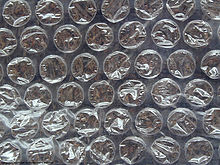Bubble wrap
Bubble wrap (colloquially bang film sticking foil, blister, blister sheet or Popp film , engl. Bubble wrap ) is a resilient, generally transparent , and at least two-layer plastic film that for packaging easily fragile articles ( padding ), for insulation or to the cavity filling is used.
construction
Air cushion films consist of two-layer welded polyethylene (PE), a smooth cover film and a second layer, into which round air cushions are incorporated at regular intervals by means of a knobbed cylinder and a vacuum roller, which serve to absorb impacts. Three-layer versions have a second smooth cover film and are therefore more resilient. Small-nubbed foils have a nub diameter of around 10 mm, large nubbed foils 25 mm. Often, mailers are also lined with them to protect the contents from damage.
To protect electronic assemblies, air cushion films can be antistatic or made from conductive material.
Two-layer films can be rolled up or folded particularly easily. Particularly strong versions are so pressure-resistant that they can be entered without damage even with mountain boots. B. serve as a tent floor, which protects against dirt, vegetation, moisture and cold. Three-layer material can only be rolled with kinks, but has the advantage that no soil can get caught in the cavities between the knobs.
If bubble wrap is used for waterproof packing, for example by machines or car body parts, the air cushion edges are much more reliably enveloped than with simple film. If the wind blows past, the inherent rigidity and the higher weight per unit area reduce the flutter and thus the risk of tearing.
Air cushions are often used to fill transport packaging instead of large nubby air cushion films. These consist of a regularly subdivided, air-filled film tube. They are perforated between the paired weld seams for easier separation.
development
Bubble wrap was coincidentally invented in 1957 by engineers Alfred Fielding and Marc Chavannes in a garage in Hawthorne, New Jersey . They were actually looking for a new type of plastic wallpaper . The wallpaper should be easy to wash off and it should also be easier to attach to the wall than with the usual paper material. They discovered that their wallpaper would also make a very light and at the same time robust packaging material, and added small air bubbles to the plastic.
On November 27, 1959, the inventors registered their packaging film with the name "Bubble Wrap" at the US patent office and one year later founded the Sealed Air Company based in Elmwood Park in the US state of New Jersey , which now specializes in the production of various plastic packaging concentrated, including air cushion and foam films, air cushion mailers, membrane cushion and fixation packaging and various systems for product protection (air bag systems, paper cushion systems and direct foam packaging systems). The Sealed Air Company took over Instapak in 1976, Sentinel in 1991 and the Cryovac Division in 1998 from the US chemical company WR Grace and Company .
Since 2000, production has also been carried out in Germany at the Alsfeld location . In 2006 the company achieved sales of US $ 4.3 billion and employed 17,000 people worldwide. In 2009, the company achieved sales of around 4.2 billion US dollars with 16,000 employees in over 100 production sites and in 52 countries.
Cultural effects
There are many fan sites on the Internet dedicated to bubble wrap. These deal with a special peculiarity: the pressing of the air bubbles, which causes a small bang. This is where the colloquial term pop film comes from . There are also electronic toys (Bubblewrap Keychain) in the form of key fobs that imitate the effect. The bubble wrap has also found its way into the New York Museum of Modern Art as a "Humble Masterpiece" as a design exhibit. Since 2001, the "Bubble Wrap Appreciation Day" has been celebrated in the USA every year on the last Monday in January.
Web links
Individual evidence
- ↑ http://www.packagingknowledge.com/bubble_film_bags.asp
- ↑ According to Forbes , the breakthrough came with a marketing expert who originally used as an insulating film for greenhouses for packaging IBM products.
- ↑ An everyday product with a bang factor. (No longer available online.) ORF, archived from the original on January 31, 2010 ; Retrieved February 22, 2013 . Info: The archive link was inserted automatically and has not yet been checked. Please check the original and archive link according to the instructions and then remove this notice.
- ↑ Bubble Wrap® Appreciation Day. Sealed Air, accessed February 22, 2013 .


